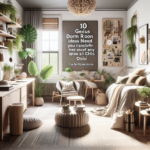
Introduction to Tuscan House Style from the 2000s
The Tuscan house style from the 2000s brought the rustic elegance of Italy into homes worldwide. Imagine warm terra-cotta flooring underfoot, aged wood beams above, and rich, earthy tones enveloping your walls. This style captures the essence of the Italian countryside, blending it with the practicality and comfort of modern homes. If you’re yearning to infuse your space with this timeless charm, you’re in the right place.
In this guide, we’ll explore compelling ways to bring the Tuscan house 2000s aesthetic into your home, transforming it into a sanctuary of warmth and sophistication.
Understanding the Essence of Tuscan Style
Before diving into practical tips, it’s crucial to grasp the foundational elements that define this style:
Key Characteristics
Earthy Color Palette: Think terracotta, olive green, ochre, and deep reds.
Natural Materials: Stone, wood, and wrought iron feature prominently.
Textures and Patterns: Plaster walls, textured tiles, and ornate mosaics.
Aged Finishes: Distressed wood and antiqued metal add depth and character.
Architectural Elements
Arched Doorways: Gentle curves soften the transitions between rooms.
Exposed Beams: Bring rustic charm and structural interest.
Stonework: Often used for fireplaces and feature walls.
Transforming Your Space: 7 Inspiring Ways
1. Warm Color Palette
To capture the Tuscan vibe, start by updating your color scheme:
Walls: Opt for warm yellows, rich terracotta, or olive greens.
Accents: Use deep reds and golds in fabrics and accessories to add depth.
2. Incorporate Natural Materials
Introduce natural textures to bring authenticity and warmth:
Flooring: Use travertine, terra-cotta tiles, or reclaimed wood.
Furniture: Choose pieces with wrought iron details or distressed finishes.
3. Textured Walls
Smooth walls are a modern staple, but Tuscan design thrives on texture:
Plaster Finishes: Venetian plaster or faux finishes can mimic aged walls.
Stone Accents: Consider a stone feature wall or a stone-clad fireplace.
4. Rustic Furniture
Select furniture that exudes a sense of history and craftsmanship:
Dining Tables: Opt for long, sturdy tables with a distressed finish.
Seating: Choose leather or tapestry-upholstered chairs with intricate woodwork.
5. Wrought Iron Details
Wrought iron brings an old-world charm that is quintessentially Tuscan:
Lighting: Chandeliers and sconces with wrought iron frames.
Railings and Hardware: Incorporate iron details on staircases and doors.
6. Lush Greenery
Bring the outside in with Mediterranean plants:
Olive Trees: Small indoor varieties can add a touch of Tuscany.
Herbs: Basil, rosemary, and lavender in terracotta pots evoke Italian gardens.
7. Timeless Accessories
Complete the look with curated decor items:
Ceramics: Hand-painted tiles or pottery add authentic flair.
Artworks: Landscapes or still-lifes with a vintage feel.
Textiles: Use wool or cotton throws and cushions in complementary colors.
Bringing It All Together
Designing a Cohesive Look
To ensure your Tuscan-inspired space feels cohesive, keep these tips in mind:
- Balance: Mix textures and patterns carefully to avoid overwhelming your space.
- Consistency: Use a consistent color palette throughout your home.
- Accent Pieces: Select a few key pieces that define the theme and build around them.
Practical Tips for DIY Enthusiasts
Aging Techniques: Explore DIY tutorials on distressing furniture or creating faux plaster walls.
Upcycling: Transform existing furniture with new finishes or hardware.
Conclusion
Embracing the Tuscan house 2000s style is about creating a home that feels warm, inviting, and timeless. By incorporating natural materials, rich textures, and a harmonious color palette, you can transport yourself to the rolling hills of the Italian countryside every day. Whether you’re renovating or simply looking to refresh your space, these insights and tips will guide you toward crafting a home that celebrates the beauty and elegance of Tuscan design.


